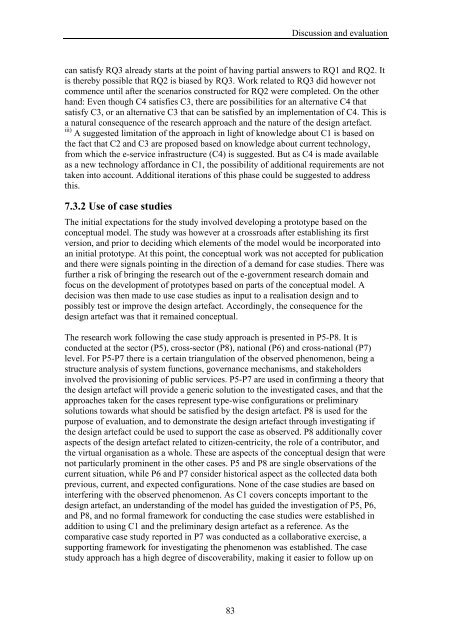Multi-channel provisioning of public services - Department of ...
Multi-channel provisioning of public services - Department of ...
Multi-channel provisioning of public services - Department of ...
You also want an ePaper? Increase the reach of your titles
YUMPU automatically turns print PDFs into web optimized ePapers that Google loves.
Discussion and evaluation<br />
can satisfy RQ3 already starts at the point <strong>of</strong> having partial answers to RQ1 and RQ2. It<br />
is thereby possible that RQ2 is biased by RQ3. Work related to RQ3 did however not<br />
commence until after the scenarios constructed for RQ2 were completed. On the other<br />
hand: Even though C4 satisfies C3, there are possibilities for an alternative C4 that<br />
satisfy C3, or an alternative C3 that can be satisfied by an implementation <strong>of</strong> C4. This is<br />
a natural consequence <strong>of</strong> the research approach and the nature <strong>of</strong> the design artefact.<br />
iii) A suggested limitation <strong>of</strong> the approach in light <strong>of</strong> knowledge about C1 is based on<br />
the fact that C2 and C3 are proposed based on knowledge about current technology,<br />
from which the e-service infrastructure (C4) is suggested. But as C4 is made available<br />
as a new technology affordance in C1, the possibility <strong>of</strong> additional requirements are not<br />
taken into account. Additional iterations <strong>of</strong> this phase could be suggested to address<br />
this.<br />
7.3.2 Use <strong>of</strong> case studies<br />
The initial expectations for the study involved developing a prototype based on the<br />
conceptual model. The study was however at a crossroads after establishing its first<br />
version, and prior to deciding which elements <strong>of</strong> the model would be incorporated into<br />
an initial prototype. At this point, the conceptual work was not accepted for <strong>public</strong>ation<br />
and there were signals pointing in the direction <strong>of</strong> a demand for case studies. There was<br />
further a risk <strong>of</strong> bringing the research out <strong>of</strong> the e-government research domain and<br />
focus on the development <strong>of</strong> prototypes based on parts <strong>of</strong> the conceptual model. A<br />
decision was then made to use case studies as input to a realisation design and to<br />
possibly test or improve the design artefact. Accordingly, the consequence for the<br />
design artefact was that it remained conceptual.<br />
The research work following the case study approach is presented in P5-P8. It is<br />
conducted at the sector (P5), cross-sector (P8), national (P6) and cross-national (P7)<br />
level. For P5-P7 there is a certain triangulation <strong>of</strong> the observed phenomenon, being a<br />
structure analysis <strong>of</strong> system functions, governance mechanisms, and stakeholders<br />
involved the <strong>provisioning</strong> <strong>of</strong> <strong>public</strong> <strong>services</strong>. P5-P7 are used in confirming a theory that<br />
the design artefact will provide a generic solution to the investigated cases, and that the<br />
approaches taken for the cases represent type-wise configurations or preliminary<br />
solutions towards what should be satisfied by the design artefact. P8 is used for the<br />
purpose <strong>of</strong> evaluation, and to demonstrate the design artefact through investigating if<br />
the design artefact could be used to support the case as observed. P8 additionally cover<br />
aspects <strong>of</strong> the design artefact related to citizen-centricity, the role <strong>of</strong> a contributor, and<br />
the virtual organisation as a whole. These are aspects <strong>of</strong> the conceptual design that were<br />
not particularly prominent in the other cases. P5 and P8 are single observations <strong>of</strong> the<br />
current situation, while P6 and P7 consider historical aspect as the collected data both<br />
previous, current, and expected configurations. None <strong>of</strong> the case studies are based on<br />
interfering with the observed phenomenon. As C1 covers concepts important to the<br />
design artefact, an understanding <strong>of</strong> the model has guided the investigation <strong>of</strong> P5, P6,<br />
and P8, and no formal framework for conducting the case studies were established in<br />
addition to using C1 and the preliminary design artefact as a reference. As the<br />
comparative case study reported in P7 was conducted as a collaborative exercise, a<br />
supporting framework for investigating the phenomenon was established. The case<br />
study approach has a high degree <strong>of</strong> discoverability, making it easier to follow up on<br />
83
















